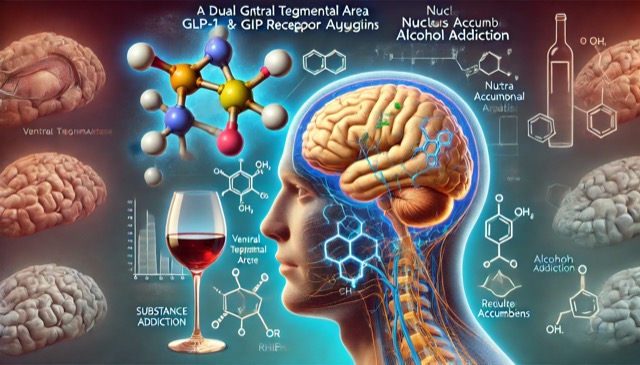
Substance abuse, particularly alcohol addiction, remains a global health crisis with far-reaching physical, emotional, and societal consequences. Despite advancements in medicine, effective treatment strategies for addiction are often elusive due to the complex interplay of biological, psychological, and environmental factors that underpin the disorder. A promising new avenue of research involves tirzepatide, a novel medication originally developed for managing diabetes and obesity. This multi-receptor agonist is now being explored for its potential to address addiction, particularly alcohol use disorder (AUD). Its mechanisms and therapeutic promise could revolutionize how addiction is treated.
Tirzepatide is a dual glucose-dependent insulinotropic polypeptide (GIP) and glucagon-like peptide-1 (GLP-1) receptor agonist. By mimicking these naturally occurring hormones, tirzepatide influences metabolism, appetite, and insulin sensitivity. In the context of diabetes and obesity, these effects result in better glycemic control, reduced food intake, and significant weight loss.
What makes tirzepatide particularly interesting for addiction treatment is the role of GLP-1 receptors in the brain. Beyond their metabolic effects, GLP-1 receptors are located in areas such as the mesolimbic dopamine system—a neural network crucial to reward, motivation, and reinforcement. Substance abuse hijacks this system, leading to compulsive behaviors and cravings. By modulating GLP-1 signaling, tirzepatide may restore balance in the reward pathways, potentially reducing cravings and substance-seeking behaviors.
Alcohol addiction, or alcohol use disorder (AUD), is characterized by an inability to control alcohol consumption despite its negative consequences. Chronic alcohol use alters the brain’s reward system, increasing dopamine release and reinforcing drinking behaviors. Over time, these changes lead to tolerance, dependence, and withdrawal symptoms.
Key areas of the brain affected by alcohol include the ventral tegmental area (VTA) and the nucleus accumbens, both of which are central to the dopamine reward pathway. GLP-1 receptors in these areas may be overactivated in addiction. Emerging research suggests that targeting these receptors could normalize activity in the reward system, reducing the reinforcing effects of alcohol.
GLP-1 receptor agonists like liraglutide and exenatide—predecessors to tirzepatide—have shown promise in preclinical and clinical studies on addiction. Research in animal models has demonstrated that GLP-1 agonists can:
Tirzepatide, with its dual action on GLP-1 and GIP receptors, could amplify these effects. Studies suggest that GIP may also influence brain functions related to reward and reinforcement, providing a synergistic benefit when combined with GLP-1 activity.
While direct studies on tirzepatide and alcohol addiction are limited, its known mechanisms and results from related drugs provide a strong rationale for further exploration. Here’s how tirzepatide could address key challenges in treating alcohol addiction:
Tirzepatide’s ability to modulate the brain’s reward pathways can weaken the powerful cravings that drive alcohol use. By reducing the dopamine surges triggered by alcohol, the drug may lessen the psychological reinforcement that perpetuates addiction.
Alcohol addiction is often accompanied by obesity, metabolic dysfunction, and mental health disorders such as depression and anxiety. Tirzepatide’s metabolic benefits—including improved insulin sensitivity, weight loss, and anti-inflammatory effects—could provide comprehensive support to patients dealing with these overlapping conditions.
Relapse remains a major hurdle in addiction treatment. Tirzepatide’s potential to stabilize brain chemistry and improve overall health may enhance the likelihood of sustained recovery. Moreover, its ability to reduce appetite and impulsivity could translate to reduced substance-seeking behaviors.
While tirzepatide offers exciting possibilities, several challenges must be addressed:
The potential of tirzepatide in addiction medicine warrants comprehensive research. Key priorities include:
Additionally, research should explore personalized approaches, identifying biomarkers or patient characteristics that predict the best outcomes with tirzepatide.
Tirzepatide’s role in addiction treatment will likely complement existing interventions, including counseling, behavioral therapy, and support groups. Combining pharmacological and psychosocial approaches could address both the biological and psychological aspects of addiction, offering patients a more holistic path to recovery.
Furthermore, integrating tirzepatide into harm-reduction strategies may expand its impact. For example, individuals struggling with severe AUD but unable to achieve complete abstinence could benefit from reduced cravings and consumption, improving their quality of life and overall health.
Tirzepatide represents a compelling new frontier in addiction medicine. By targeting the neurochemical roots of alcohol addiction through its dual action on GLP-1 and GIP receptors, the drug has the potential to transform how substance abuse disorders are treated. While significant research is still needed, early evidence and theoretical models suggest that tirzepatide could reduce cravings, improve physical health, and support long-term recovery for individuals battling alcohol addiction.
As the global burden of substance abuse continues to rise, innovative solutions like tirzepatide are essential. With further research and clinical validation, this medication could emerge as a powerful tool in the fight against addiction, offering hope to millions worldwide.
